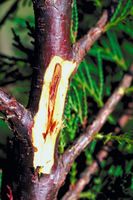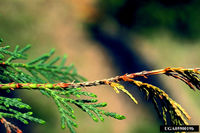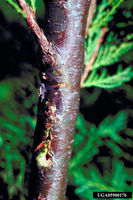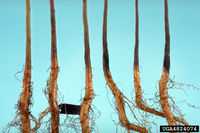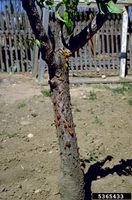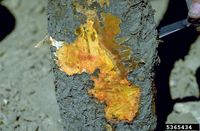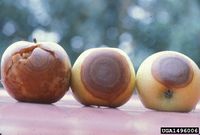Botryosphaeria dothidea
| Literature database |
|---|
| 256 articles sorted by: |
| • year (descending) |
| • research topics |
| • countries/regions |
| • host plants |
| • list of antagonists |

Author(s): A.J.L. Phillips, A. Alves, J. Abdollahzadeh, B. Slippers, M.J. Wingfield, J.Z. Groenewald and P.W. Crous
Source: Studies in Mycology, 2013, 76, p.75
Botryosphaeria dothidea (Moug. ex Fr. 1823) Ces. & De Not. 1863
The fungus has a worldwide distribution and infects a large variety of woody crops, like fruit crops (e.g. grapevine, mango or apple), nuts (e.g. pistachio) or forest trees. The diseases caused include cankers, dieback, fruit rot, stem-end rot and shoot blight. Other symptoms have been described as resin flow, yellowing, wilting, gummosis and browning of the leaves, followed by leaf drop. Fruit infections may result in more than 50% yield losses.
The fungus enters the plant through small wounds (e.g. pruning wounds) and may survive as endophyte becoming a pathogen if the host is stressed. Conidia are predominantly dispersed by rain splashes, while ascospores spread in both air and water.
| Vernacular names | |
|---|---|
| • English: | bot rot of apple white rot of apple apple ring rot excoriose of grapevine |
| • Español: | chancro del almendro |
| • Français: | excoriose de la vigne chancre de l'amandier |
The fungus forms pycnidia which produce conidia. These are mainly fusiform, aseptate, widest near the middle and around 25 x 4 µm large. Pseudothecia which produce ascospores have been also observed in nature. Ascospores are ellipsoid, around 20 x 10 µm large.
For a review see Marsberg et al. (2017).
Synonyms:
Botryosphaeria berengeriana
Fusicoccum aesculi
- Other images of Botryosphaeria dothidea (IPM Images - click to enlarge)
